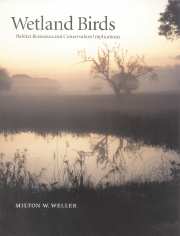Book contents
- Frontmatter
- Contents
- List of plates
- Preface
- Acknowledgments
- 1 Introduction
- 2 Wetlands: what, where, and why
- 3 Major groups of birds that use wetlands
- 4 Water and other resource influences
- 5 Foods, feeding tactics, strategies, and guilds
- 6 Bird mobility and wetland predictability
- 7 Other behavioral and physical influences on wetland living
- 8 Spatial and structural patterns
- 9 Habitat dynamics: water, plant succession, and time
- 10 Population consequences of wetland abundance and quality
- 11 How birds influence wetlands
- 12 Conservation implications
- 13 Measures of bird habitat use and quality
- 14 Current status and some conservation problems
- 15 Conservation and management strategies
- 16 Outlook
- 17 Epilogue
- Appendix 1 Scientific names of birds and bird groups
- Appendix 2 Scientific names of animals and animal groups other than birds
- Appendix 3 Scientific names of plants and plant groups
- Index of birds and bird groups
- Subject index
13 - Measures of bird habitat use and quality
Published online by Cambridge University Press: 02 October 2009
- Frontmatter
- Contents
- List of plates
- Preface
- Acknowledgments
- 1 Introduction
- 2 Wetlands: what, where, and why
- 3 Major groups of birds that use wetlands
- 4 Water and other resource influences
- 5 Foods, feeding tactics, strategies, and guilds
- 6 Bird mobility and wetland predictability
- 7 Other behavioral and physical influences on wetland living
- 8 Spatial and structural patterns
- 9 Habitat dynamics: water, plant succession, and time
- 10 Population consequences of wetland abundance and quality
- 11 How birds influence wetlands
- 12 Conservation implications
- 13 Measures of bird habitat use and quality
- 14 Current status and some conservation problems
- 15 Conservation and management strategies
- 16 Outlook
- 17 Epilogue
- Appendix 1 Scientific names of birds and bird groups
- Appendix 2 Scientific names of animals and animal groups other than birds
- Appendix 3 Scientific names of plants and plant groups
- Index of birds and bird groups
- Subject index
Summary
To apply some of the concepts and principles noted in previous chapters, biologists typically measure habitat quality for birds for a variety of purposes (Adamus et al. 1987, 1991, Bookout 1994): (i) ornithologists or ecologists studying the biology and ecology of individual species or groups; (ii) ecologists studying how birds are distributed in space and time; (iii) wildlife managers measuring habitat use or habitat quality to assess the effectiveness of some form of management; (iv) consultants selecting alternatives for habitat creation or restoration projects; (v) conservation biologists setting priorities for purchase or lease options to protect species, habitats, or communities; (vi) conservation or regulatory agencies evaluating the effectiveness of a wetland mitigation (i.e., replacement) project and subsequent monitoring of success in meeting goals; and (vii) regulatory biologists and population managers following trends in populations, measuring effects of harvest regulations, or evaluating environmental impacts,
Population size and density often are used as indicators of good or poor habitat, but such data have numerous biases and are expensive to obtain. However gathered, it is also essential to have measurements of habitat features to correlate with the population indices to provide some relative scale of quality. Measurement of habitat condition for a particular animal commonly is termed habitat suitability, but some workers advise against use of the word “suitability” as redundant (i.e., it either is or is not habitat) and recommend the word “quality” instead (Hall, Krausman and Morrison 1997). However, “suitability” is an integral part of a widely used evaluation system (see below) that describes a range of features attractive to and indicative of habitat quality for the species in question.
- Type
- Chapter
- Information
- Wetland BirdsHabitat Resources and Conservation Implications, pp. 199 - 212Publisher: Cambridge University PressPrint publication year: 1999



